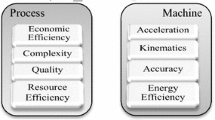Abstract
With the aim of achieving improved motion control, modelling and control methods for pneumatic and electric drives are considered. The use of both conceptual and analytic models for controlling single-degree-of-freedom pneumatic and electric modules is reported, supported by experimental results. The approaches described relate to a research programme which has evolved a novel family of modular machine elements that can be aggregated to form a wide variety of types of manufacturing machine.
Similar content being viewed by others
Abbreviations
- A :
-
effective piston area
- d :
-
the control signal
- ë, e, e :
-
acceleration, velocity and position errors
- f :
-
coefficient of viscous friction
- F :
-
external force
- F c :
-
column friction (sliding friction)
- k p ,k v ,k a ,k i :
-
position, velocity, acceleration and integral loop gains
- K s :
-
load stiffness
- l :
-
half-length of the stroke for pneumatic cylinders
- m :
-
mass of gas in pneumatic control chambers
- m e :
-
equivalent mass of the motor, transmission and load
- M :
-
piston mass (including load) for pneumatic cylinders
- N :
-
gas-flow parameter
- p :
-
chamber pressure
- p c :
-
exhaust pressure
- p s :
-
supply pressure
- R :
-
ideal gas constant
- T :
-
absolute chamber temperature
- V :
-
chamber volume
- x :
-
piston position (relative to mid-position of cylinder stroke)
- ωn :
-
natural frequency
- ξ:
-
damping ratio
- a:
-
refers to the control chamber on the supply side
- b:
-
refers to the control chamber on the exhaust side
- s:
-
denotes a steady state (when used together with another subscript)
References
R. H. Weston, R. Harrison, A. H. Booth and P. R. Moore, “Universal machine control system primitives for modular distributed manipulator systems”,International Journal of Production Research, special issue, on robotics, pp. 395–410, January 1989.
R. H. Weston, R. Harrison, AA. H. Booth and P. R. Moore, “A new concept in machine control”,Computer-Integrated Manufacturing Systems,2(2), pp. 115–122, 1989.
R. H. Weston, P. R. Moore, T. W. Thatcher and C. Morgan, “Computer controlled pneumatic servo drives”,Proceedings of the Institution of Mechanical Engineers, Part B.198(4), pp. 275–281, 1984.
P. R. Moore, R. H. Weston and T. W. Thatcher, “Control of pneumatic servo drives uding digital compensation”,IASTED International Symposium on Telecommunication and Control, Halkidiki, Greence, pp. 264–268, August 1984.
R. Nagarajan and R. H. Weston, “Front-end control schemes for pneumatic servo driven modules”,Proceedings of the Institution of Mechanical Engineers, Part B,199(4), pp. 271–277, 1985.
P. R. Moore, “Pneumatic motion control systems for modular robots”, PhD thesis, Loughborough University of Technology, 1986.
C. R. Burrows, “Effect of position on the stability of pneumatic servo mechanisms”,Research Notes in Mechanical Engineering Science,II(6), pp. 615–616, 1969.
D. McCloy and H. R. Martin,Control of Fluid Power: Analysis and Design, 2nd edn., Ellis Horwood, West Sussex, 1980.
J. Pu, “Advancements in the programmable motion control of pneumatic drives for robots and other flexible machines”, PhD thesis, Loughborough University of Technology, 1988.
J. J. Craig,Introduction to Robotics: Mechanics and Control Addison-Wesley, Wokingham, England, 1986.
G. Rogers and R. H. Weston, “A knowledge-based approach to robot axis control”,IEEE International Conference on Robotics and Automation, Raleigh, NC, pp. 363–368, 1987.
V. B. Brooks,The Neural Basis of Motion Control, Oxford University Press, 1986.
C. H. An, C. Atkeson, J. Griffiths and J. Hollerbach, “Experimental evaluation of feedforward and computerised torque control”,Proceedings of IEEE International Conference on Robotics and Automation, pp. 165–168, 1986.
H. Asada and K. Youcef-Toumi,Direct Drive Robots, MIT Press, Cambridge, MA, USA, 1987.
W. Backe, “The application of servo-pneumatic drives for flexible mechanical handling techniques”,Robotics 2, North Holland, pp. 45–56.
Author information
Authors and Affiliations
Rights and permissions
About this article
Cite this article
Pu, J., Rogers, G. & Weston, R.H. The use of models in the motion control of pneumatic and electric drives. Int J Adv Manuf Technol 4, 349–368 (1989). https://doi.org/10.1007/BF02604335
Accepted:
Issue Date:
DOI: https://doi.org/10.1007/BF02604335




